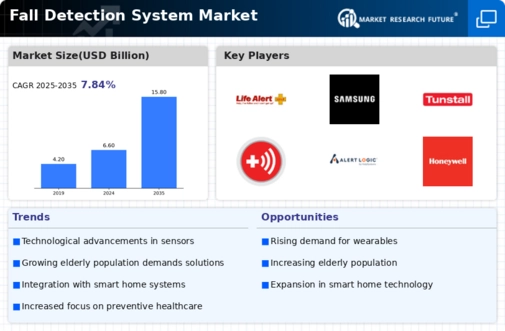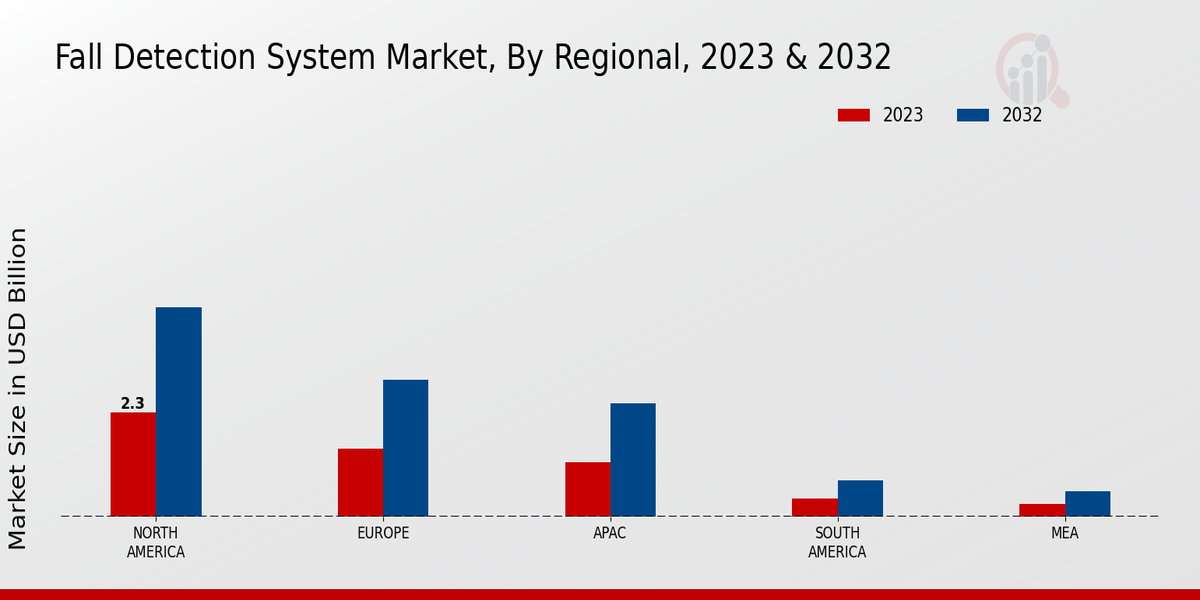Aging Population
The Global Fall Detection System Market Industry is significantly driven by the aging population, which is projected to reach 1.5 billion people aged 65 and older by 2050. This demographic shift leads to an increased incidence of falls, prompting a higher demand for fall detection systems. In 2024, the market is valued at 6.6 USD Billion, reflecting the urgent need for solutions that enhance safety for seniors. As the population ages, the market is expected to grow, with estimates suggesting it could reach 15.8 USD Billion by 2035, indicating a robust compound annual growth rate (CAGR) of 8.24% from 2025 to 2035.
Healthcare Sector Growth
The expansion of the healthcare sector is a crucial driver for the Global Fall Detection System Market Industry. As healthcare systems evolve and expand, there is a corresponding increase in the demand for innovative solutions that enhance patient safety. Hospitals and care facilities are increasingly adopting fall detection systems as part of their patient care protocols. This trend is likely to continue, with the market expected to grow from 6.6 USD Billion in 2024 to 15.8 USD Billion by 2035. The anticipated CAGR of 8.24% from 2025 to 2035 reflects the healthcare sector's commitment to improving safety and reducing fall-related incidents.
Market Growth Projections
The Global Fall Detection System Market Industry is poised for substantial growth, with projections indicating a rise from 6.6 USD Billion in 2024 to 15.8 USD Billion by 2035. This growth trajectory is underpinned by a compound annual growth rate (CAGR) of 8.24% from 2025 to 2035. The increasing prevalence of falls, particularly among the elderly, coupled with advancements in technology and heightened awareness of fall risks, suggests a robust market environment. As stakeholders across various sectors recognize the importance of fall detection systems, the industry is likely to witness significant investment and innovation in the coming years.
Technological Advancements
Innovations in technology are propelling the Global Fall Detection System Market Industry forward. The integration of artificial intelligence and machine learning into fall detection systems enhances their accuracy and responsiveness. For instance, wearable devices equipped with advanced sensors can now detect falls in real-time and alert caregivers or emergency services. This technological evolution not only improves user safety but also increases market appeal. As a result, the industry is witnessing a surge in investment and development, which is likely to contribute to the projected growth from 6.6 USD Billion in 2024 to 15.8 USD Billion by 2035.
Increased Awareness of Fall Risks
There is a growing awareness of fall risks among healthcare providers and caregivers, which is influencing the Global Fall Detection System Market Industry. Educational initiatives and campaigns aimed at highlighting the dangers associated with falls, particularly among the elderly, are becoming more prevalent. This heightened awareness leads to increased adoption of fall detection systems, as stakeholders recognize their potential to save lives and reduce healthcare costs. The market's growth trajectory, from 6.6 USD Billion in 2024 to an anticipated 15.8 USD Billion by 2035, underscores the importance of these systems in mitigating fall-related injuries.
Government Initiatives and Funding
Government initiatives aimed at improving elderly care and reducing fall-related injuries are significantly impacting the Global Fall Detection System Market Industry. Various countries are implementing policies that promote the adoption of fall detection technologies, often accompanied by funding and subsidies. For example, programs that provide financial assistance for home modifications and safety devices are becoming more common. Such initiatives not only enhance the accessibility of fall detection systems but also encourage their integration into standard care practices. This supportive environment is expected to facilitate market growth, with projections indicating an increase from 6.6 USD Billion in 2024 to 15.8 USD Billion by 2035.





















